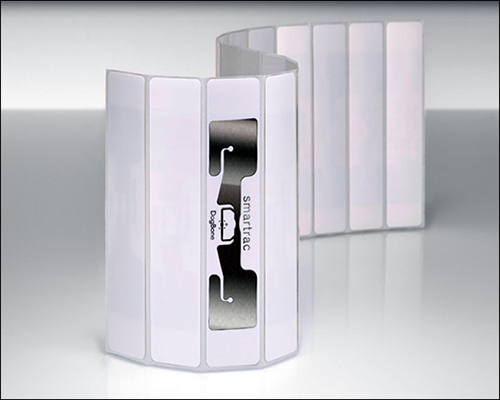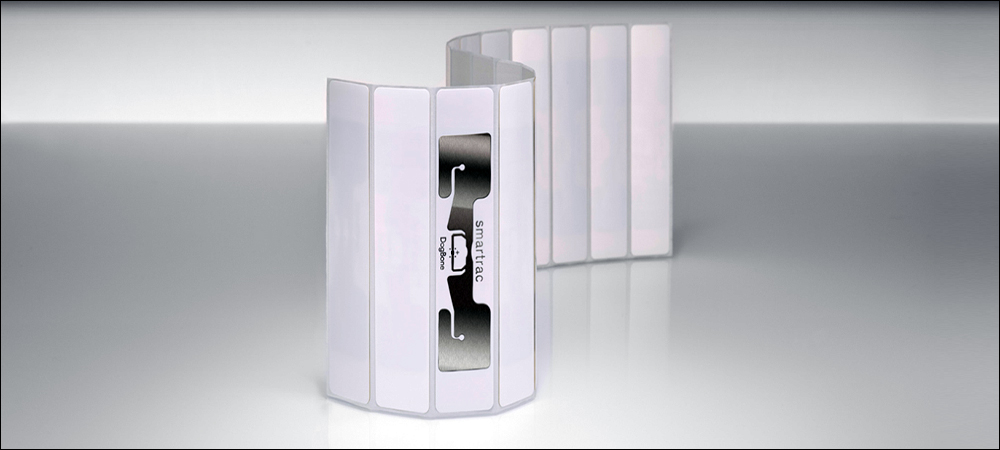Smartrac has released its new DOGBONE DURA passive UHF RFID tag for industrial, supply chain and logistics applications. According to the company, the tag is designed to sustain immersion in water and pressurized water cleaning, as well as other challenging environmental conditions, but is still be priced similarly to a standard UHF RFID tag. The tag is flexible enough to go through a printer and be stored in rolls, Smartrac reports.
Several companies in the industrial and logistics sectors are piloting the new tag, the technology firm indicates, in order to determine its effectiveness in tracking goods or equipment that may be exposed to water or other conditions that could damage standard UHF RFID labels. The Dutch RFID inlay manufacturer sold its RFID product line last year to Avery Dennison, but it continues to design and develop RFID tags under the Smartrac brand name. The DURA tag was designed to meet the needs of companies in multiple sectors. One key application is tracking reusable items through the supply chain.

The DOGBONE DURA tag
For instance, says Juha Virtanen, Smartrac’s global head of R&D, those managing the movements of returnable transportation items (RTIs), pallets, totes and waste bins require visibility into the movements of such items, but they may find standard RFID tags will not operate well in their environment. They might need a tag that can survive washing processes, mechanical stresses and outdoor use, Virtanen says, but at a relatively low cost. An application might also benefit from a tag that could be printed with a standard printer. “That’s exactly where our DURA products fit the bill,” Virtanen states.
An alternative to standard UHF labels has been highly durable plastic tags. However, Virtanen says, these tend to be built for extremely rugged environments that might require imperviousness to chemicals, extreme heat or heavy impacts. That could include oil and gas or utility-based deployments. Such hard-tag solutions can be comparatively expensive when used instead of standard flexible tags, Virtanen notes. As a result, he says, “There is a high demand for extra-durable tags that cost less than full-blown hard tags.”
Another benefit of the DOGBONE DURA tag, according to Smartrac, is its design for easy encoding and printing. The DURA can be printed with a printer used for standard flexible tags, says Antti Valtonen, Smartrac’s senior technical product manager for DURA and FLEX tags and materials. In some cases, the firm explains, standard printers may require adjustments, as the DOGBONE DURA is slightly thicker than a standard inlay. The thickness ranges from 460 to 520 micrometers (microns), depending on the delivery format (dry or wet).
Smartrac has tested both the printing and encoding of the DOGBONE DURA with the CL4NX printer from SATO. A bracket accessory can be added to raise the platen gap to further improve the printing process if necessary, Valtonen says. Zebra Technologies offers specific RFID printers designed for printing “thicker on metal labels,” which can be even thicker than the DOGBONE DURA. The DURA comes with two semi-stiff thermostet layers, with the IC and antenna sandwiched between them in order to protect those electronics. The encapsulation brings the product protection level to an IP68 rating. At the same time, the company notes, the layers are flexible.
While the tag is less expensive than a hard tag, Smartrac reports, it will be priced higher than a standard RFID tag. “It’s obvious that the material and manufacturing expenses for DOGBONE DURA are higher than for standard DOGBONE tags,” Valtonen says. The price for the DOGBONE DURA reflects that. However, it “also reflects its extra value in customer applications.”

Juha Virtanen
The company predicts that this extra value for use in challenging environments will justify the price. For instance, a standard RFID tag could be destroyed with each washing or sanitizing cycle for a piece of equipment. When that occurs, companies must attach a new printed and encoded RFID label to that item and enter its ID number into software—a process that costs both labor and materials.

Antti Valtonen
The DURA comes with a built-in Impinj Monza R6-P chip with Autotune functionality. The tag can be provided in either wet or dry formats and is delivered in reels. With a wet inlay, the label comes with an industrial-grade adhesive designed to be chemical- and water-resistant. The dry version of the tag comes with an extension for users to punch holes and attach with screws or ties.
Beyond tracking goods such as RTIs, there may be other use cases for RFID in industries such as construction, Virtanen says. “The DURA tags can also be embedded inside concrete,” he notes, which would make it possible for inspectors, government employees or others to identify work done underground on a particular road or sidewalk, for instance, by employing a handheld reader to interrogate the tag.
The encapsulation thereby enables the use of these tags in environments for which hard tags have been too expensive. “Due to the cost advantages of DURA products over hard tags, we suspect an increased usage of RFID technology” by some companies, Valtonen states, in areas where hard tags were not considered economically feasible.


